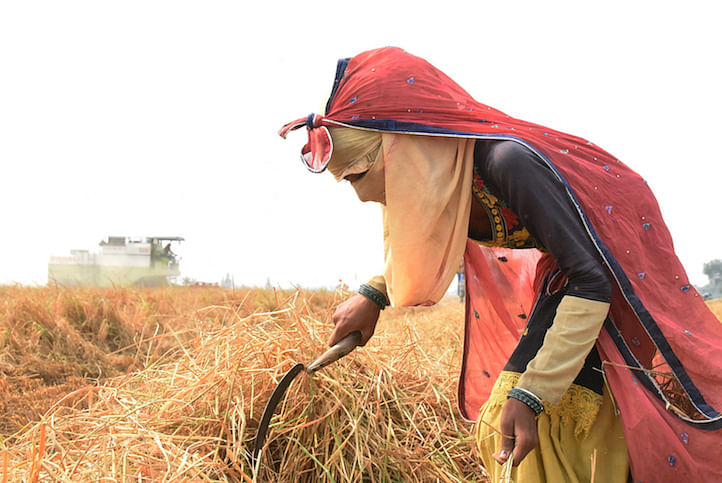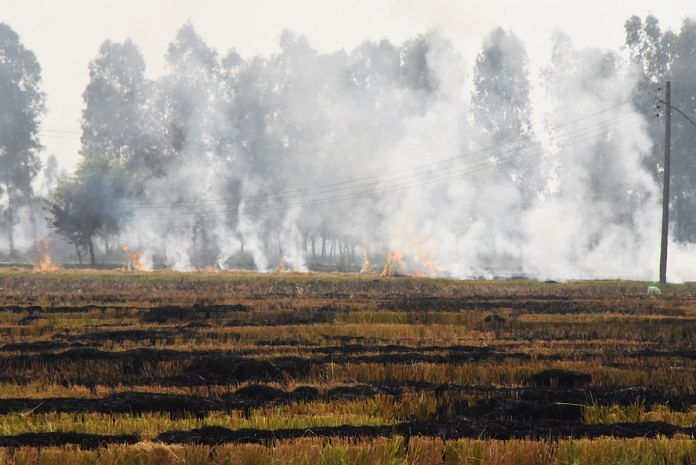Patiala: Punjab, it seems, is fighting a losing battle against crop stubble burning, a major contributor to air pollution in the National Capital Region.
Even as the state is pushing for “in-situ” management of paddy straw as an alternative to burning it, most farmers seem reluctant to give up their age-old practice in the absence of any government incentive.
“The best way to tackle the huge quantity of straw generated is to incorporate it back into the soil (in situ). Not only it improves the soil quality, but also reduces the use of chemical fertiliser. This will further help the farmer save money,” K.S. Pannu, chairman of Punjab Pollution Control Board, told ThePrint.
Last November, the National Green Tribunal had banned crop residue burning in five states — Punjab, Haryana, Rajasthan, Uttar Pradesh and Delhi. Even the Delhi High Court had directed these states to ensure that the ban is enforced.
Punjab had implemented a slew of measures to check the menace, but they did not yield the desired results. While the state government’s focus is now on in-situ management of paddy residue, ThePrint found that farmers continued to burn stubble defying court orders although most are aware that what they are doing is not just illegal but also harming the environment.
“We are not getting any incentive from the government to manage crop residue. We will continue to burn it, even if we get arrested,” said a farmer from Patiala, which was declared a ‘model district’ for stubble burning ban.
Punjab generates 19.7 million tonne of paddy straw on 30 lakh hectares of agricultural land every year. Of this, 4.3 (21.82 per cent) million tonne is used in biomass-based power plants, cardboard mills and as animal fodder. This leaves 15.4 million tonne of paddy straw unused, and it ends up being burnt.

With no options left, the state is trying to popularise the “in-situ” management of crop stubble, calling it the “most economically viable option” to dispose of the paddy leftover.
This is how it works: a farmer would require, at the time of harvesting, two extra labourers to do the job. This entails an extra expenditure of Rs 700 an acre. Two tonnes of straw generated in an acre, if incorporated into the soil, increase the next crop’s yield by a quintal, adding Rs 1,600 per acre to the farmer’s income, said officials. The amount of fertilizer required is also reduced, saving another Rs 1,000 per acre for the farmer, they said.
“We have conducted almost 2,500 awareness campaigns until August. Also, 28 specially designed publicity vans have visited 4,200 villages and we will continue to run them until 31 October. About 30,000 pamphlets have been distributed as well,” said Pannu.
Meanwhile, as of 14 October the Punjab Remote Sensing Station recorded 1052 cases of stubble burning this season compared with 1,700 cases in 2016. Pannu also expects a drastic drop in the number of farmers resorting to straw burning this year.
“In Punjab out of the 12 lakh farmers involved in stubble burning, we expect the number to reduce to less than 1 lakh this year,” he added.

Chief minister Captain Amarinder Singh has already approached the Union agriculture ministry for Rs 2,000-crore assistance to compensate the farmers — they would be provided Rs 100 per quintal for paddy straw management so that they do not burn their crop residue.
The state has, over the years, tried various methods to stop this practice. Sources said the agriculture department had given over Rs 2,000 lakh as subsidies to farmers to purchase specialised machinery to process the paddy leftover. These include balers, choppers, rotavators, happy seeders, and rakes.
These machines cost anywhere between Rs 40,000 and Rs 10 lakh, which most farmers find unaffordable.
“For a one-month activity, how can we spend so much on purchasing the machines,” asked Sinder Singh, a farmer.
The government is also trying to reuse paddy straw to produce power. Seven biomass-based projects with a total production capacity of 62.5 MW have been set up. However, their total consumption of paddy straw is just 1 million tonne, which is barely a fraction of the total generation.
Last month, the state government tied up with a private player, Ruchira Papers Ltd, for setting up a Rs 1,000-crore plant to make paper from agricultural residue.







The govt. or admin. is not serious about problem and method proposed by them called insitu or burying the residue in field in impractical for the reason that residue of paddy and root-stem of paddy plant makes sowing of next crop that is wheat very difficult as it does not decompose in the soil. The residue takes more then 6 months to decompose whereas the intermediate period of harvesting and sowing is a month or so. So its a mere eyewash and people are suffocating. Real solutions are needed like small units to process it into paper or packaging material which will be biodegradable. Converting paddy straw to fuel wood or blocks . And also utilising it for electricity production in small thermal plants with necessary changes for particulate matter.
Good Swapna, done a good job. Useful one for our country from air pollution..
well written…swapna….all the best…go ahead…
Excellent story! Nayanika Chatterjee, good work with the camera! Hopefully, we in Delhi will be able to breathe better now.